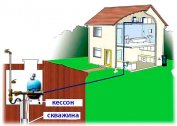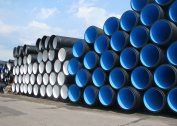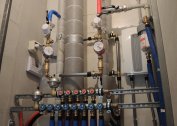The centralized water supply system is a complex network providing the population with hot and cold water. It is constantly being improved and modernized, acquiring new technical parameters.
Definition and scope
 The centralized water supply system consists of functional units designed for the extraction, preparation and delivery of resources to the consumer within a specific locality. Water can be taken from open ground and closed underground sources. Before being delivered to consumers, the collected resources are cleaned.
The centralized water supply system consists of functional units designed for the extraction, preparation and delivery of resources to the consumer within a specific locality. Water can be taken from open ground and closed underground sources. Before being delivered to consumers, the collected resources are cleaned.
Centralized water supply is hot and cold. It mainly operates in cities, large cottage villages. In some cases, water pipes are connected to industrial buildings located within the boundaries of settlements.
Regulatory requirements
When organizing central water supply, state regulatory requirements must be observed regarding the arrangement of external networks (SNiP 2.04.02-84) and internal water supply of buildings (2.04.01-85). These documents govern the design of the system, the features of placement and the characteristics of its structural elements.
Regulatory requirements regarding the quality of water used for household and drinking purposes are indicated in SanPiN 2.1.4.1074-01, GOST 2874-82. The documents also spelled out the rules for exercising control over its characteristics. The standards are binding for legal entities, entrepreneurs whose activities are associated with the design, construction and operation of centralized water supply.
Characteristics and types of sources
 Water is taken from sources that must meet a number of requirements:
Water is taken from sources that must meet a number of requirements:
- Control the presence of hazardous contaminants. This rule is especially true for lakes where there is no natural flow.
- When choosing surface sources, water intake facilities are placed on a section of a river with a stable channel. This prevents their destruction.
- The fence is organized above the mouth of the tributaries flowing into the river. This approach reduces the likelihood of additional contaminants entering the source.
- An equipped system should ensure uninterrupted supply of resources in the required amount.
The surface sources include rivers, lakes, artificial reservoirs and reservoirs with a depth of at least 2.5 m. They are divided into channel, bucket, and coastal. For artificial sources, the depth of the fence should be as large as possible. This will allow you to get water with optimal performance. At great depths, there is no flowering effect. Also, there is no fence from the highly mineralized layer, which is usually located closer to the surface.
As underground sources, hydrological systems located in the upper layers of the earth's crust are chosen. These are groundwater, artesian wells, high water. Water intake is organized at a minimum distance from the village, provide for the possibility of expansion with increasing water consumption. This scheme has many advantages - high quality water and the constancy of its parameters.
When using underground sources, boreholes are usually equipped. They have a depth of hundreds of meters, which allows you to simultaneously operate multiple horizons. The well is a round shaft.Its walls are made of metal pipe, which makes their destruction impossible. To ensure the required volume of water intake, several wells are usually equipped.
System device
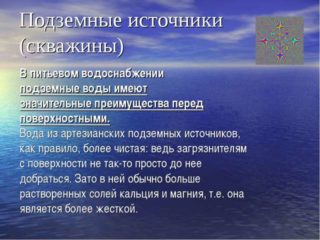 The scheme of the centralized water supply in the cottage village or in the big city is the same. The network configuration is determined by the type of sources used.
The scheme of the centralized water supply in the cottage village or in the big city is the same. The network configuration is determined by the type of sources used.
The groundwater
When using underground sources, the system includes:
- wells;
- first lift pumps - move water to a special underground tank;
- pumps of the second rise - pump out the contents of the tanks and move it to the distribution network;
- filter - designed to detain large particles in the aquifer;
- water tank.
Horizontal water intakes consist of a receiving and outlet part. In the latter, unauthorized diversion of water to the well and pump station is observed.
When using sources in the form of open springs, capturing devices are used. Water enters the chamber, passing through the filter without fail. It is also protected from external contaminants. The fence takes place from the bottom or hole in the wall of the capturing chamber.
Surface sources
 If water is taken from open water bodies, the system includes:
If water is taken from open water bodies, the system includes:
- water intake facilities;
- devices used to improve the quality of extracted resources;
- distribution network.
When taking water from open reservoirs there is a special receiver. It is equipped in the form of a coastal well or bucket. The rise of water to wastewater treatment plants is carried out using pumps.
Connection Terms
In order to use centralized water supply for domestic and drinking purposes, you must apply to the appropriate authorities (local Vodokanal). At the request of the consumer, the institution provides technical specifications.
Employees of Vodokanal are developing schemes for connecting to the main pipeline, indicate the location and depth of the pipelines. Based on the received technical conditions, specialists equip all the necessary components from the distribution well to metering devices.
Differences between hot and cold centralized water supply
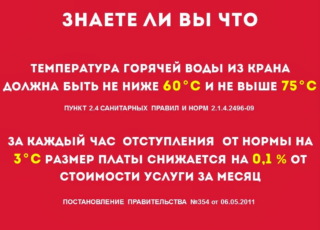 State regulatory documents indicate that settlements should have centralized hot and cold water supply. They provide the population with a resource of the same quality. The difference lies in the different requirements.
State regulatory documents indicate that settlements should have centralized hot and cold water supply. They provide the population with a resource of the same quality. The difference lies in the different requirements.
Cold water supply complies with the following standards:
- provides consumers with a resource around the clock throughout the year;
- in the absence of hot water, water can be heated using water heaters;
- the maximum duration of the anhydrous period is 8 hours per month (excluding emergency situations).
For domestic hot water there are requirements for water temperature. It cannot deviate from the normative by more than 3-5 ° C. The shutdown of water in the event of an accident lasts no longer than 24 hours.
Advantages and disadvantages
The advantages of centralized water supply include:
- round-the-clock access to an unlimited source of water;
- network maintenance is carried out by specialized services without involving the consumer in the process;
- high quality of supplied resources.
The disadvantages of the system include the need for constant control over the consumption of resources, on the basis of which payment is made. Often there is a need for additional water purification from rust and chlorine.
